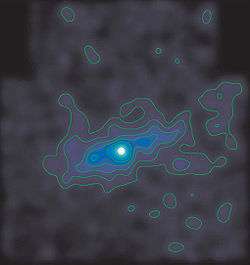Hercules (dwarf galaxy)
| Hercules Dwarf Galaxy[1] | |
|---|---|
|
Hercules has an elongated shape. | |
| Observation data (J2000 epoch) | |
| Constellation | Hercules |
| Right ascension | 16h 31m 02s[1] |
| Declination | +12° 47′ 30″[1] |
| Distance |
479+26 −23 kly (147+8 −7 kpc),[2] 430+39 −39 kly (133+6 −6 kpc[3]) |
| Apparent magnitude (V) | 14.7 ± 0.5[4] |
| Characteristics | |
| Type | dSph[4] |
| Apparent size (V) | 16.8′[4] |
| Other designations | |
| Her,[1] PGC 4713560 | |
Hercules, or Her, is a dwarf spheroidal galaxy situated in the Hercules constellation and discovered in 2006 in data obtained by the Sloan Digital Sky Survey.[4] The galaxy is located at a distance of about 140 kpc from the Sun and moves away from the Sun with a velocity of about 45 km/s.[4][5] It is classified as a dwarf spheroidal galaxy (dSph). Her has a noticeably elongated (ratio of axes ~ 3:1) shape with a half-light radius of about 350 pc.[4][6][note 1] This elongation may be caused by tidal forces acting from the Milky Way galaxy, meaning that Her is being tidally disrupted now.[3] Her also shows some gradient of velocities across the galaxy's body[7] and is embedded into a faint stellar stream,[3] which also points towards its ongoing tidal disruption.
Her is one of the smallest and faintest satellites of the Milky Way—its integrated luminosity is about 30,000 times that of the Sun (absolute visible magnitude of about −6.6),[note 2] which is comparable to the luminosity of a typical globular cluster.[4][6] However, its total mass is about 7 million solar masses, which means the galaxy's mass to light ratio is around 330. A high mass to light ratio implies that Her is dominated by dark matter.[5][note 3]
The stellar population of Her consists mainly of old stars formed more than 12 billion years ago.[3] The metallicity of these old stars is also very low at [Fe/H] ≈ −2.58 ± 0.51,[note 4] which means that they contain 400 times less heavy elements than the Sun.[8] The stars of Her were probably among the first stars to form in the Universe. Currently there is no star formation in Her.[3] Measurements have so far failed to detect neutral hydrogen in it—the upper limit is 466 solar masses.[9]
Notes
- ↑ From other sources the half-radius is around 230 pc.[3]
- ↑ From other sources the absolute magnitude is around −5.3.[3]
- ↑ It is difficult to estimate the mass of such faint galaxies due to significant foreground contamination, which inflates the velocity dispersion. A paper published in 2009 arrived at a lower mass estimate of about 2 million solar masses within the half-radius; the total mass within 433 pc was estimated at about 4 million solar masses.[7]
- ↑ From other sources the metallicity is around −2.3.[2][5]
References
- 1 2 3 4 "SIMBAD Astronomical Database". Results for Her Dwarf Galaxy. Retrieved 2010-02-22.
- 1 2 Adén, D.; Feltzing, S.; Koch, A. (2009). "A photometric and spectroscopic study of the new dwarf spheroidal galaxy in Hercules. Metallicity, velocities, and a clean list of RGB members". Astronomy and Astrophysics. 546 (3): 1147–1168. arXiv:0908.3489
 . Bibcode:2009A&A...506.1147A. doi:10.1051/0004-6361/200912718.
. Bibcode:2009A&A...506.1147A. doi:10.1051/0004-6361/200912718. - 1 2 3 4 5 6 7 Sand, David J.; Olszewski, Edward W.; Willman, Beth (2009). "The Star Formation History and Extended Structure of the Hercules Milky Way Satellite". The Astrophysical Journal. 704 (2): 898–914. arXiv:0906.4017
 . Bibcode:2009ApJ...704..898S. doi:10.1088/0004-637X/704/2/898.
. Bibcode:2009ApJ...704..898S. doi:10.1088/0004-637X/704/2/898. - 1 2 3 4 5 6 7 Belokurov, V.; Zucker, D. B.; Evans, N. W.; Kleyna, J. T.; Koposov, S.; Hodgkin, S. T.; Irwin, M. J.; Gilmore, G.; Wilkinson, M. I.; Fellhauer, M.; Bramich, D. M.; Hewett, P. C.; Vidrih, S.; De Jong, J. T. A.; Smith, J. A.; Rix, H. ‐W.; Bell, E. F.; Wyse, R. F. G.; Newberg, H. J.; Mayeur, P. A.; Yanny, B.; Rockosi, C. M.; Gnedin, O. Y.; Schneider, D. P.; Beers, T. C.; Barentine, J. C.; Brewington, H.; Brinkmann, J.; Harvanek, M.; Kleinman, S. J. (2007). "Cats and Dogs, Hair and a Hero: A Quintet of New Milky Way Companions". The Astrophysical Journal. 654 (2): 897. arXiv:astro-ph/0608448
 . Bibcode:2007ApJ...654..897B. doi:10.1086/509718.
. Bibcode:2007ApJ...654..897B. doi:10.1086/509718. - 1 2 3 Simon, J. D.; Geha, M. (2007). "The Kinematics of the Ultra‐faint Milky Way Satellites: Solving the Missing Satellite Problem". The Astrophysical Journal. 670: 313. arXiv:0706.0516
 . Bibcode:2007ApJ...670..313S. doi:10.1086/521816.
. Bibcode:2007ApJ...670..313S. doi:10.1086/521816. - 1 2 Martin, N. F.; De Jong, J. T. A.; Rix, H. W. (2008). "A Comprehensive Maximum Likelihood Analysis of the Structural Properties of Faint Milky Way Satellites". The Astrophysical Journal. 684 (2): 1075. arXiv:0805.2945
 . Bibcode:2008ApJ...684.1075M. doi:10.1086/590336.
. Bibcode:2008ApJ...684.1075M. doi:10.1086/590336. - 1 2 Adén, D.; Wilkinson, M.I.; Read, J.I. (2009). "A new low mass for the Hercules dSph: the end of a common mass scale for the dwarfs?". The Astrophysical Journal Letters. 706 (1): L150–L154. arXiv:0910.1348
 . Bibcode:2009ApJ...706L.150A. doi:10.1088/0004-637X/706/1/L150.
. Bibcode:2009ApJ...706L.150A. doi:10.1088/0004-637X/706/1/L150. - ↑ Kirby, E. N.; Simon, J. D.; Geha, M.; Guhathakurta, P.; Frebel, A. (2008). "Uncovering Extremely Metal-Poor Stars in the Milky Way's Ultrafaint Dwarf Spheroidal Satellite Galaxies". The Astrophysical Journal. 685: L43. arXiv:0807.1925
 . Bibcode:2008ApJ...685L..43K. doi:10.1086/592432.
. Bibcode:2008ApJ...685L..43K. doi:10.1086/592432. - ↑ Grcevich, J.; Putman, M. E. (2009). "H I in Local Group Dwarf Galaxies and Stripping by the Galactic Halo". The Astrophysical Journal. 696: 385. arXiv:0901.4975
 . Bibcode:2009ApJ...696..385G. doi:10.1088/0004-637X/696/1/385.
. Bibcode:2009ApJ...696..385G. doi:10.1088/0004-637X/696/1/385.

